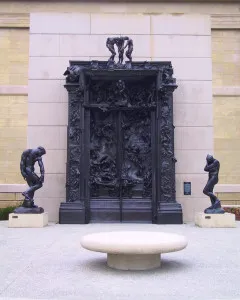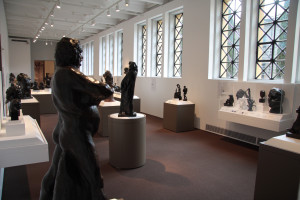
While “The Gates of Hell” might not sound like the ideal spot for a picnic, the bronze cast of Auguste Rodin’s 20-foot masterpiece is just one of 20 renowned sculptures on display at the Cantor Arts Center’s Rodin Sculpture Garden. The center’s must-see Rodin collection — the largest outside of Paris — also includes three galleries in the museum’s left wing, which together house 170 Rodin pieces. And it’s all free.
Auguste Rodin (1840-1917) was a pioneer of modern sculpture and a master of the human figure who believed that a single body part could express great emotion. Some of his figures seem rough or unfinished — “The Prayer” depicts a woman’s headless torso with much of her arms and legs cut off and “Large Clenched Left Hand” is exactly what it sounds like – yet dynamic, as if the frozen figures could come to life with a breath.
As David Brown, a visitor from Rockville, Md., told me, “When you look at the statues, you know they’re thinking.”
In fact, one of Rodin’s most famous works is called “The Thinker” and can be found in two places at Cantor, sitting hunched and muscular at the center of the Diekman Gallery and in miniature atop “The Gates of Hell,” whose doors are covered in a tangle of about 180 bodies. Rodin originally created the figure as “The Poet,” a sculpture of Dante himself looking down at the tormented souls from the “Inferno.”
Other familiar faces from the Gates stand life-sized just a few paces away in the garden, allowing visitors to truly appreciate the doors’ detail. “The Gates of Hell” features a plaque quoting art historian Albert E. Elsen.
“They never fail to surprise,” said Elsen. “[They change] as one changes, rewarding age and experience.”

Fittingly, there’s something in Cantor’s Rodin collection for all ages to enjoy and, even if you’re not a serious art lover, it’s still worth visiting Cantor for the ambiance. On hot summer afternoons, the sculpture garden provides a shaded place to sit, eat lunch and admire part of a world-class art collection, while the museum café is also delicious. Stop by the main lobby at 2 p.m. on Wednesdays, 11:30 a.m. on Saturdays or 3 p.m. on Sundays and take a guided tour of the Rodin collection if you can. The museum is open Wednesdays through Sundays from 11 a.m. to 5 p.m. (8 p.m. on Thursdays), but the garden stays open all hours — with lighting at night that makes the sculptures appear more eerily alive than ever.
